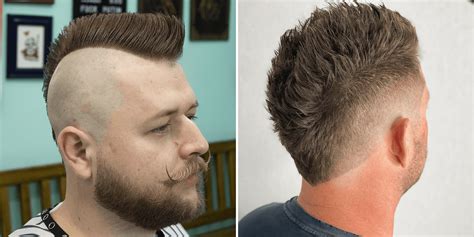When it comes to edgy hairstyles, the faux hawk and mohawk reign supreme. Both styles feature a dramatic strip of raised hair, but they differ in key aspects that set them apart for distinct personalities and aesthetics. In this comprehensive guide, we’ll delve into the 5 fundamental differences between faux hawks and mohawks.

1. Hair Length: The Base of the Style
Faux Hawk:
– Hair is typically trimmed short on the sides and back, creating a contrast with the raised central strip.
– Length on top can range from short (2-4 inches) to medium (4-6 inches), allowing for some versatility.
Mohawk:
– Hair on the sides and back is shaved or trimmed extremely short, emphasizing the central strip.
– The hair on top is typically longer, ranging from 4 to 8 inches or even longer.
2. Width of the Raised Section: A Matter of Preference
Faux Hawk:
– The raised section is narrower, often 2-3 inches wide, giving it a more subtle and versatile appearance.
– Can be styled with a variety of products to achieve different looks.
Mohawk:
– The raised section is significantly wider, typically 4-6 inches or more, creating a bolder and more aggressive aesthetic.
– Requires more hairspray or gel to maintain its shape.
3. Height of the Raised Section: Achieving the Desired Impact
Faux Hawk:
– The raised section is usually styled to a moderate height, allowing it to stand out without being too extreme.
– Height can vary depending on the individual’s preference and face shape.
Mohawk:
– The raised section is typically styled to a higher height, often reaching 4-6 inches or more above the scalp.
– This creates a strong visual impact and is suitable for individuals who want to make a bold statement.
4. Maintenance: The Time and Effort Involved
Faux Hawk:
– Requires less maintenance than a mohawk due to its shorter length and narrower raised section.
– Regular trims and styling products are sufficient to maintain its shape.
Mohawk:
– Requires more frequent maintenance, including regular trims to keep the sides short and regular styling to keep the raised section in place.
– This hairstyle is best suited for individuals who are willing to invest the time and effort in upkeep.
5. Suitability: Finding the Right Fit
Faux Hawk:
– Suitable for a wide range of face shapes and hair types.
– Versatile enough for both casual and formal occasions.
Mohawk:
– Best suited for oval or oblong face shapes and thick, straight hair.
– Typically reserved for informal occasions or individuals with an edgy or rebellious style.
Benefits of Faux Hawks and Mohawks
Both faux hawks and mohawks offer unique benefits that appeal to different individuals:
- Faux Hawk:
- Adds height to the face for a more flattering appearance.
- Can be customized to suit personal style with different lengths and styling techniques.
-
Versatile and suitable for various occasions.
-
Mohawk:
- Makes a strong visual statement and exudes confidence.
- Gives the illusion of increased height, especially when styled to a significant height.
- Provides a sense of individuality and rebellion.
How to Style a Faux Hawk or Mohawk
Faux Hawk:
- Trim the sides and back of the hair short, leaving the top section longer.
- Apply a styling product (mousse or gel) to damp hair.
- Divide the top section into two equal parts.
- Lift one half of the top section and tease it to create volume.
- Smooth down the teased hair and secure it with hairspray.
- Repeat the process on the other half of the top section.
- Finish with more hairspray to hold the style in place.
Mohawk:
- Shave or trim the sides and back of the hair very short.
- Section off the top section of hair that will form the mohawk.
- Apply a generous amount of hair gel or pomade to the mohawk section.
- Backcomb the mohawk section to create volume.
- Smooth down the hair and shape it using a brush or comb.
- Secure the mohawk with ample hairspray.
Conclusion
Faux hawks and mohawks are two dramatic hairstyles that cater to different preferences and aesthetics. While both feature a raised section of hair, they differ in hair length, width of the raised section, height of the raised section, maintenance requirements, and suitability. The faux hawk provides a more versatile and subtle option, while the mohawk exudes confidence and individuality with its bold and aggressive appearance. Ultimately, the choice between a faux hawk and a mohawk depends on personal style and the desired impact.
